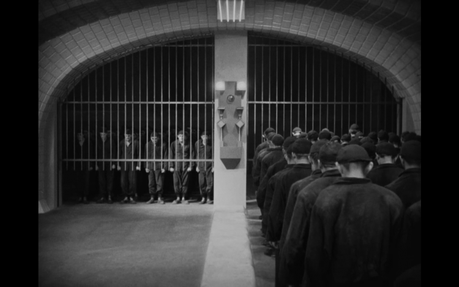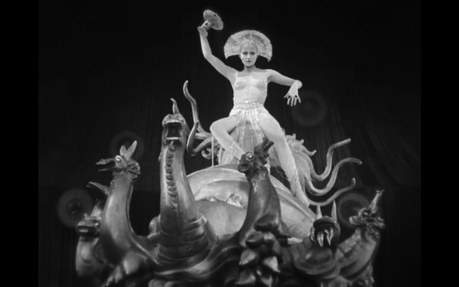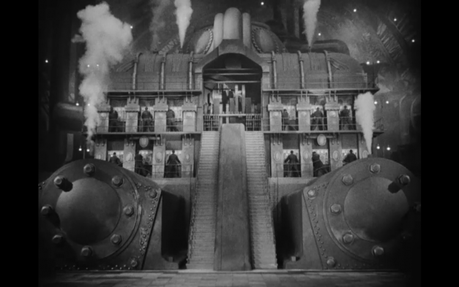why-you-need-to-see-metropolis
It’s difficult to overstate the importance of Metropolis. It was absolutely essential to the creation of science fiction as a whole. Not only this, but it comes from a deeply stylized artistic genre that only works in silent film, an art lost to film history. Metropolis is considered German Expressionist, a full fledged artistic as well as filmic movement, with heavy symbolism and art-deco set design. The film is carried by the main female character, Maria, played by Brigitte Helm. Maria and her double are the catalysts for the entire film.
Largely considered by film critics as a late entry into the German Expressionist film canon, Metropolis can’t be taken strictly at face value. German Expressionism came as a reaction against realism, and the high aesthetics of the sets speak to the symbolic nature of much of the film. Viewers today might not say that Metropolis is particularly subtle (the first title card reads: “The mediator between head and hands must be the heart!” – laying out explicitly the metaphor for the entire film), but the symbolism works on several levels, and that overt symbolism covers up multiple levels of delicate, covert symbolism.
The movie is about a city, set far in the future, that is dependent on an oppressed lower class to run machinery constantly, or the city will malfunction on a catastrophic level. The upper class enjoys a city of light, with all the riches and technology they might need or want. The lower class lives under the city, and the upper class never has to see them. They walk in unison to and from work, as if they lack an identity outside of their job. Their jobs are mindless, but desperately important. If no one is there to run the machines, the lower city is in danger of flooding entirely.
Tags:
Albums: Kazantip
Comment
-
Comment by Maria De Wind on September 28, 2013 at 2:26am
-
-
Comment by Sweettina2 on March 14, 2013 at 11:33pm
-
I've seen Metropolis a couple of times....wild! And yep, very symbolic.
-
Comment by Central Scrutinizer on February 14, 2013 at 12:14am
-
doing the math here, thats roughly 85-100 million marks in 2012.....wow
-
Comment by Maria De Wind on February 14, 2013 at 12:13am
-
Comment by Maria De Wind on February 14, 2013 at 12:08am
-
Comment by Central Scrutinizer on February 13, 2013 at 11:55pm
-
have it on DVD, discovered this gem long time ago in school, tis a my fav of the 20's SF genre. Film included more than 37,000 extras including 25,000 men, 11,000 women, 1,100 bald men, 750 children, 100 dark-skinned people and 25 Asians. Being one of the most expensive movies of the time, costing around 5,000,000 marks, this film nearly sent UFA (Universum Film) into bankruptcy.
-
Comment by Maria De Wind on February 13, 2013 at 11:43pm
-
Comment by Maria De Wind on February 13, 2013 at 11:41pm
-
Silent film itself provides a set of unique challenges for both director and star. The actors are challenged to act primarily through body language – almost like dancers – and the extreme and expressive make-up conveys meaning beyond the forms. Today, seeing a film without a bombast of sound is a rare experience (with the exception of surprise hit The Artist). Mainstream directors have mostly done away with the idea of the silent film, and the experience may be new for a lot of viewers. Metropolis is a masterpiece, and while some viewers may need to adjust to the style, it resonates deeply for fans of science fiction and dystopia.
-
Comment by Maria De Wind on February 13, 2013 at 11:40pm
-
Largely considered by film critics as a late entry into the German Expressionist film canon, Metropolis can’t be taken strictly at face value. German Expressionism came as a reaction against realism, and the high aesthetics of the sets speak to the symbolic nature of much of the film. Viewers today might not say that Metropolis is particularly subtle (the first title card reads: “The mediator between head and hands must be the heart!” – laying out explicitly the metaphor for the entire film), but the symbolism works on several levels, and that overt symbolism covers up multiple levels of delicate, covert symbolism.
The movie is about a city, set far in the future, that is dependent on an oppressed lower class to run machinery constantly, or the city will malfunction on a catastrophic level. The upper class enjoys a city of light, with all the riches and technology they might need or want. The lower class lives under the city, and the upper class never has to see them. They walk in unison to and from work, as if they lack an identity outside of their job. Their jobs are mindless, but desperately important. If no one is there to run the machines, the lower city is in danger of flooding entirely.

Freder is the son of the wealthiest man in Metropolis, and has lived a life of leisure. One day while frolicking in the garden, Maria disturbs him by ushering in children of the workers. Freder, who has never seen one of the workers, is so moved that he wishes to join them. At the same time, a mad scientist has been working for Freder’s father, Joh Fredersen, to create a robot that would be so lifelike as to replace his dead wife. While Freder is organizing in the depths of the city, the scientist shows Fredersen what Maria is up to. Incensed, Fredersen instructs the mad scientist to capture Maria and stifle the masses. Instead of creating the robot in the dead wife’s image, he creates it in the image of Maria to sabotage her work with the lower class.
The plot is much more involved than this, but these are the major points to get to before chaos ensues in the city. Lang points to a population terrified of internal subversion using the overarching message of the mediator. The double of Maria – who is directly referenced as the “whore of Babylon” – sabotages the instincts of every story line within the film. She is not only a foil for the “good guys,” she is a foil for everything – including herself.

Maria is the only woman within the film who is given an identity separate from either sex or the machines. She is both saint and whore, in classic dichotomy, bearing both the choice and the outcome for the revolution. On the one hand, a peaceful uprising with mutually beneficial outcomes for the upper and lower classes, and on the other she represents bloody revolution and chaos out of which no good comes.
It’s a classic problem of Madonna vs. whore. In this abstract world, where symbolism is more important than reality, those are the only two options that a female character like Maria is given. Yet the male characters aren’t allowed much more depth – many of them are simply given a role, with no subtlety or realism or personality. Metropolis is less about gender in the eyes of the director/writer than it is about gender as a societal structure. The way the audience reads gender is an important clue to unlocking the symbolism of the film.

"Destroying the New World Order"
THANK YOU FOR SUPPORTING THE SITE!
Latest Activity
- Top News
- ·
- Everything
What was the Significance of the F-94 C and What role in History?
FLUORIDEGATE: An American Tragedy. a film by Dr. David Kennedy
Rendezvous With The Unknown
Shadows in the Wind
Mossad: we create a pretend world, we are a global production company... the world is our stage
The Alvin II Encounter: Was There A Living Dinosaur Involved?
© 2025 Created by truth.
Powered by
![]()
You need to be a member of 12160 Social Network to add comments!
Join 12160 Social Network